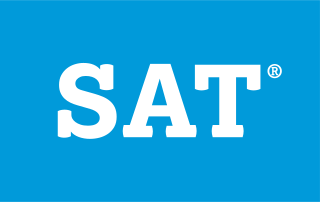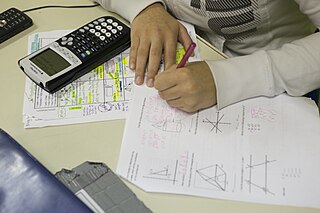Related Research Articles

The ACT is a standardized test used for college admissions in the United States. It is currently administered by ACT, a nonprofit organization of the same name. The ACT test covers four academic skill areas: English, mathematics, reading, and scientific reasoning. It also offers an optional direct writing test. It is accepted by all four-year colleges and universities in the United States as well as more than 225 universities outside of the U.S.

The SAT is a standardized test widely used for college admissions in the United States. Since its debut in 1926, its name and scoring have changed several times. For much of its history, it was called the Scholastic Aptitude Test and had two components, Verbal and Mathematical, each of which was scored on a range from 200 to 800. Later it was called the Scholastic Assessment Test, then the SAT I: Reasoning Test, then the SAT Reasoning Test, then simply the SAT.

Advanced Placement (AP) is a program in the United States and Canada created by the College Board. AP offers undergraduate university-level curricula and examinations to high school students. Colleges and universities in the US and elsewhere may grant placement and course credit to students who obtain qualifying scores on the examinations.
The Preliminary SAT/National Merit Scholarship Qualifying Test (PSAT/NMSQT) is a standardized test administered by the College Board and cosponsored by the National Merit Scholarship Corporation (NMSC) in the United States. In the 2018–2019 school year, 2.27 million high school sophomores and 1.74 million high school juniors took the PSAT. Scores from the PSAT/NMSQT are used to determine eligibility and qualification for the National Merit Scholarship Program.

The College Board is an American not-for-profit organization that was formed in December 1899 as the College Entrance Examination Board (CEEB) to expand access to higher education. While the College Board is not an association of colleges, it runs a membership association of institutions, including over 6,000 schools, colleges, universities, and other educational organizations.

Mu Alpha Theta (ΜΑΘ) is the United States mathematics honor society for high school and two-year college students. In June 2015, it served over 108,000 student members in over 2,200 chapters in the United States and in 20 foreign countries. Its main goals are to inspire keen interest in mathematics, develop strong scholarship in the subject, and promote the enjoyment of mathematics in high school and two year college students. The name is a rough transliteration of math into Greek. Buchholz High School won first place in 2023 for the 15th time in the annually held national convention.
Advanced Placement (AP) Chemistry is a course and examination offered by the College Board as a part of the Advanced Placement Program to give American and Canadian high school students the opportunity to demonstrate their abilities and earn college-level credits at certain colleges and universities. The AP Chemistry Exam has the lowest test participation rate out of all AP Courses, with around half of AP Chemistry students taking the exam.

Advanced Placement (AP) examinations are exams offered in United States by the College Board and are taken each May by students. The tests are the culmination of year-long Advanced Placement (AP) courses, which are typically offered at the high school level. AP exams have a multiple-choice section and a free-response section.
The SAT Subject Test in Chemistry was a one-hour multiple choice test given on chemistry by The College Board. A student chose whether to take the test depending upon college entrance requirements for the schools in which the student was planning to apply. Until 1994, the SAT Subject Tests were known as Achievement Tests; until January 2005, they were known as SAT 2s; they are still well known by the latter name. On January 19 2021, the College Board discontinued all SAT Subject tests, including the SAT Subject Test in Chemistry. This was effective immediately in the United States, and the tests were to be phased out by the following summer for international students. This was done as a response to changes in college admissions due to the impact of the COVID-19 pandemic on education.
The SAT Subject Test in United States History was the name of a one-hour multiple choice test given on United States History by The College Board. A student chose whether to take the test depending upon college entrance requirements for the schools in which the student is planning to apply. Until 1994, the SAT Subject Tests were known as Achievement Tests; and from 1995 until January 2005, they were known as SAT IIs. Of all SAT subject tests, United States History was taken the second most, with 119,903 administrations in 2009. On January 19, 2021, the College Board discontinued all SAT Subject tests, including the SAT Subject Test in United States History. This was effective immediately in the United States, and the tests were to be phased out by the following summer for international students. This was done as a response to changes in college admissions due to the impact of the COVID-19 pandemic on education.
The SAT Subject Test in Mathematics Level 1 was the name of a one-hour multiple choice test given on algebra, geometry, basic trigonometry, algebraic functions, elementary statistics and basic foundations of calculus by The College Board. A student chose whether to take the test depending upon college entrance requirements for the schools in which the student is planning to apply. Until 1994, the SAT Subject Tests were known as Achievement Tests; and from 1995 until January 2005, they were known as SAT IIs. Mathematics Level 1 was taken 109,048 times in 2006. The SAT Subject Test in Mathematics Level 2 covered more advanced content.
Generally you need to have completed a semester of a pre-calculus class with a solid “B” or better to feel comfortable on the Math 1, whereas the content of the Math 2 test extends through Algebra II and basic trigonometry, precalculus, and basic calculus.
The SAT Subject Test in Physics, Physics SAT II, or simply the Physics SAT, was a one-hour multiple choice test on physics administered by the College Board in the United States. A high school student generally chose to take the test to fulfill college entrance requirements for the schools at which the student was planning to apply. Until 1994, the SAT Subject Tests were known as Achievement Tests; until January 2005, they were known as SAT IIs; they are still well known by this name.
The SAT Subject Test in Biology was the name of a one-hour multiple choice test given on biology by the College Board. A student chose whether to take the test depending upon college entrance requirements for the schools in which the student is planning to apply. Until 1994, the SAT Subject Tests were known as Achievement Tests; and from 1995 until January 2005, they were known as SAT IIs. Of all SAT subject tests, the Biology E/M test was the only SAT II that allowed the test taker a choice between the ecological or molecular tests. A set of 60 questions was taken by all test takers for Biology and a choice of 20 questions was allowed between either the E or M tests. This test was graded on a scale between 200 and 800. The average for Molecular is 630 while Ecological is 591.
The SAT Subject Test in World History was the name of a one-hour multiple choice test given on World History by the College Board. A student chose to take it depending on a college's entrance requirements. Until 1994, the SAT Subject Tests were known as Achievement Tests; and from 1995 until January 2005, they were known as SAT IIs. The SAT World History was not taken frequently. Fewer than 17,000 students in 2015 took this test, compared to the over-110,000 students who took the United States History Subject Test. On January 19 2021, the College Board discontinued all SAT Subject tests, including the SAT Subject Test in World History. This was effective immediately in the United States, and the tests were to be phased out by the following summer for international students. This was done as a response to changes in college admissions due to the impact of the COVID-19 pandemic on education.

Mathematics education in the United States varies considerably from one state to the next, and even within a single state. However, with the adoption of the Common Core Standards in most states and the District of Columbia beginning in 2010, mathematics content across the country has moved into closer agreement for each grade level. The SAT, a standardized university entrance exam, has been reformed to better reflect the contents of the Common Core. However, many students take alternatives to the traditional pathways, including accelerated tracks. As of 2023, twenty-seven states require students to pass three math courses before graduation from high school, while seventeen states and the District of Columbia require four. A typical sequence of secondary-school courses in mathematics reads: Pre-Algebra, Algebra I, Geometry, Algebra II, Pre-calculus, and Calculus or Statistics. However, some students enroll in integrated programs while many complete high school without passing Calculus or Statistics. At the other end, counselors at competitive public or private high schools usually encourage talented and ambitious students to take Calculus regardless of future plans in order to increase their chances of getting admitted to a prestigious university and their parents enroll them in enrichment programs in mathematics.
The SAT Subject Test in Literature was a one-hour multiple choice test given on English literature by The College Board. A student chose whether to take the test depending upon college entrance requirements for the schools in which the student is planning to apply. Until 1994, the SAT Subject Tests were known as Achievement Tests; and from 1995 until January 2005, they were known as SAT IIs. Of all SAT subject tests, Literature was taken the third most, with 119,180 administrations in 2008. On January 19 2021, the College Board discontinued all SAT Subject tests, including the SAT Subject Test in Literature. This was effective immediately in the United States, and the tests were to be phased out by the following summer for international students. This was done as a response to changes in college admissions due to the impact of the COVID-19 pandemic on education.

SAT Subject Tests were a set of multiple-choice standardized tests given by The College Board on individual topics, typically taken to improve a student's credentials for college admissions in the United States. For most of their existence, from their introduction in 1937 until 1994, the SAT Subject Tests were known as Achievement Tests, and until January 2005, they were known as SAT II: Subject Tests. They are still commonly known by these names. Unlike the Scholastic Aptitude Test (SAT) that the College Board offers, which are intended to measure general aptitude for academic studies, the Achievement Tests are intended to measure the level of knowledge and understanding in a variety of specific subjects. Like the SAT, the scores for an Achievement Test range from 200 (lowest) to 800 (highest).
The SAT Subject Test in Spanish was a standardized test given by the College Board that assessed fluency in Spanish among high school students. It was typically taken after three to four years of studying the language, once the student had reached a significant level of understanding and competence in it. The test also partially emphasized preparation for AP Spanish and/or Spanish as a course in College. Passage selections were drawn from prose fiction, historical works, and newspaper and magazine articles, as well as advertisements, flyers and letters.
Advanced Placement (AP) Precalculus is an Advanced Placement precalculus course and examination, offered by the College Board, in development since 2021 and announced in May 2022. The course debuted in the fall of 2023, with the first exam session taking place in May 2024. The course and examination are designed to teach and assess precalculus concepts, as a foundation for a wide variety of STEM fields and careers, and are not solely designed as preparation for future mathematics courses such as AP Calculus AB/BC.
The SAT is a standardized test commonly used for the purpose of admission to colleges and universities in the United States. The test, owned by the College Board and originally developed by Carl Brigham, was first administered on June 23, 1926, to about 8,000 students. The test was introduced as a supplement to the College Board essay exams already in use for college admissions, but ease of administration of the SAT and other factors led to the discontinuation of the essay exams during World War II. The SAT has since gone through numerous changes in content, duration, scoring, and name; the test was taken by more than 1.9 million students in the graduating high school class of 2023.
References
- ↑ "Mathematics Level 2 Subject Test". SAT Suite of Assessments. 7 January 2016. Retrieved 1 June 2019.
- ↑ "Compass Education Group FAQ". Compassprep.cpm. Retrieved 1 June 2019.
- ↑ Nick Anderson, College Board is scrapping SAT’s optional essay and subject tests, Washington Post (January 19, 2021).
- ↑ "College Board Will No Longer Offer SAT Subject Tests or SAT with Essay – College Board Blog". blog.collegeboard.org. Retrieved 2021-02-14.
- ↑ Aspegren, Elinor. "Adjusting to 'new realities' in admissions process, College Board eliminates SAT's optional essay and subject tests". USA TODAY.
- ↑ "SAT Subject Tests Preparation Booklet" (PDF). The College Board. pp. 17–22. Retrieved July 2, 2007.
- ↑ "SAT Subject Test in Mathematics Level 2". The College Board . Retrieved July 2, 2007.
- 1 2 "SAT Calculator Policy". The College Board . Retrieved July 2, 2007.
- ↑ "SAT Subject Tests Preparation Booklet" (PDF). The College Board. pp. 17–22. Retrieved July 2, 2007.
- ↑ "SAT Subject Test Percentile Ranks, 2009 College-Bound Seniors" (PDF). The College Board . Retrieved May 12, 2010.
- ↑ "SAT Subject Tests Percentile Ranks : 2012 College-Bound Seniors" (PDF). Media.collegeboard.com. Retrieved 1 June 2019.